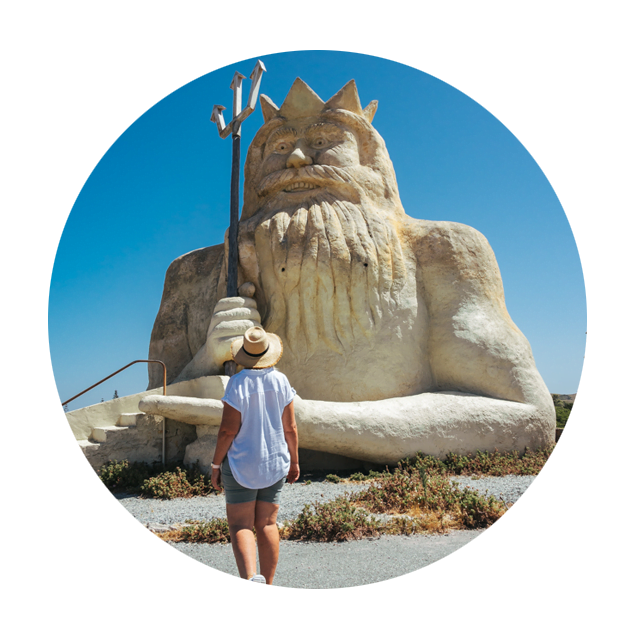Karijini National Park Ultimate Travel Guide
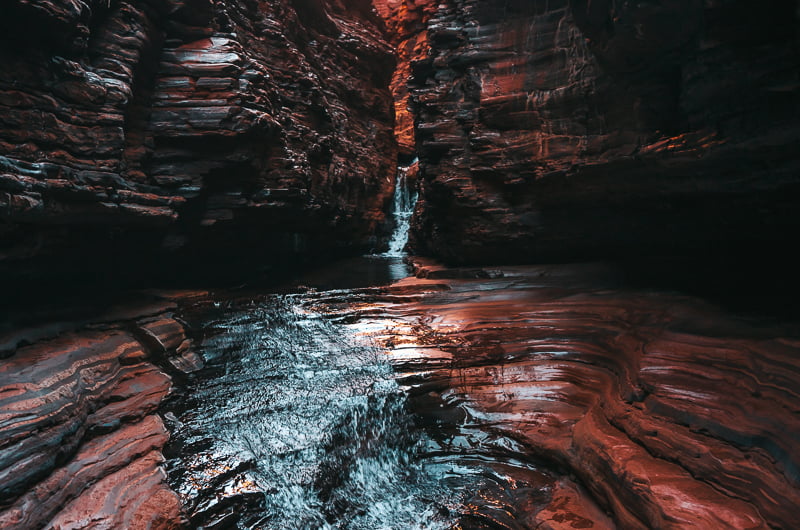
If you are planning a road trip north in Western Australia, Karijini National Park is a must-do! Two billion years in the making, it’s raw and remote. Famous for wild gorges, sheer rock faces, natural swimming holes, epic hikes, and panoramic lookouts, it’s one of the most instagrammable parks in Australia!
Where is Karijini National Park?
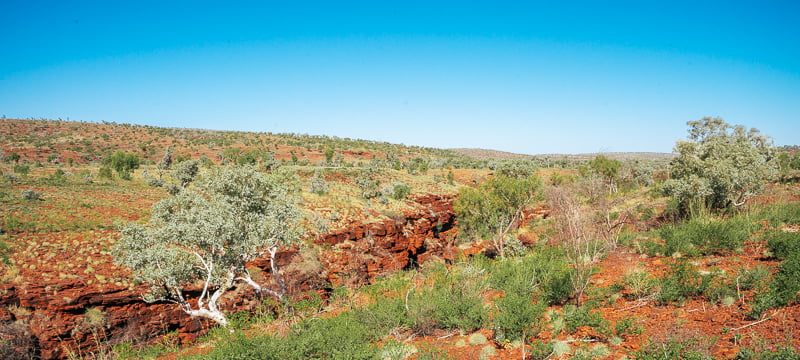
Karijini is located in the Pilbara region of Western Australia, and it really is in the middle of nowhere. But so worth every effort and difficulty in getting there!! It’s around 1,362km from Perth, or 15 hours of solid driving time if taking a direct route straight up through the centre of WA.
The more scenic route is to drive along Australia’s Coral Coast if you have the time. Explore the stunning Western Australian coastline on the way and visit Kalbarri, Shark Bay and Carnarvon. A few days in Exmouth is recommended before driving inland to Karijini (about 7hrs). But if driving long-distance is not your thing, Qantas operates flights to Paraburdoo around 2.5 hours south of the Park.
Transportation options in and out of Karijini National Park are extremely limited. You will need a car or a 4WD. The roads to Karijini are sealed but many within the National Park are gravel.
About Karijini National Park
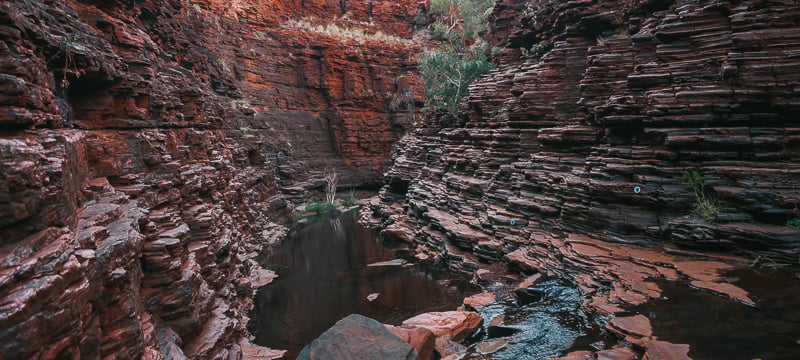
Karijini protects over 6,000 km² area of the state’s tallest and most impressive mountains in the Hamersley Range. The red dirt semi-arid desert reveals the most incredible cavernous gorges, the oldest rocks on the planet, crystal-clear waterways and hidden oases. Formed over billions of years these ancient gorges, polished by water and age, have some of the oldest rocks on the planet.
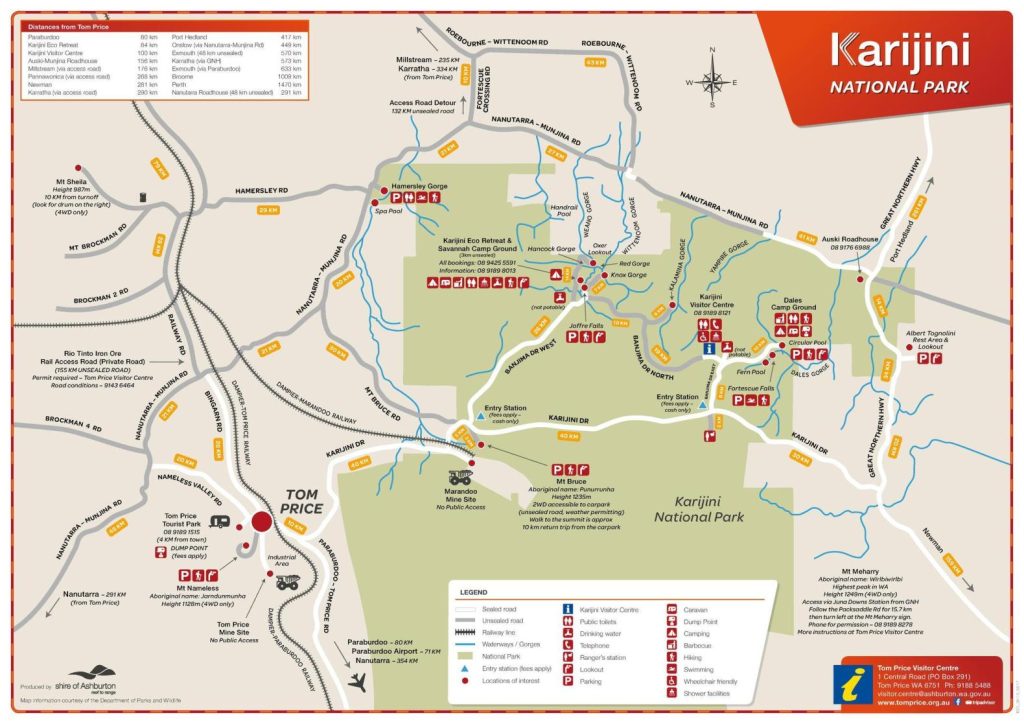
The Park is the traditional home of the Banyjima, Kurrama and Innawonga Aboriginal people. Karijini is the Banyjima name for the Hamersley Range in their local language. Many places within the park are sacred to Aboriginal people. To protect the heritage, cultural and environmental values of these areas please follow all Park’s instructions.
When to visit Karijini?
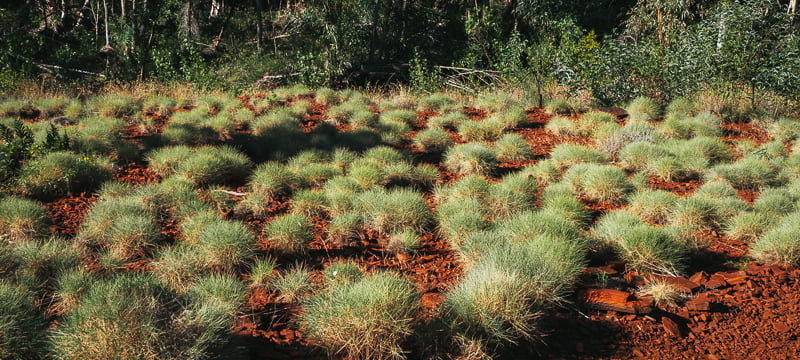
Being a semi-arid desert, Karijini is a place of extreme temperature fluctuations. You can get freezing cold winter nights, scorching hot winter days and massive, heavy rainfall in the summer. The Pilbarra experiences wet and dry seasons. Wet season (also the lowest visitor season) runs roughly from late October through to March. Dry season (peak visitor season) runs from March through to October.
The summer months can be intensely hot and humid, and not a good time to visit unless you enjoy a tropical storm. The park is quieter during the low season and campsites can close. Gorges may be too dangerous to enter, as there is a danger of flash flooding.
Where to stay?
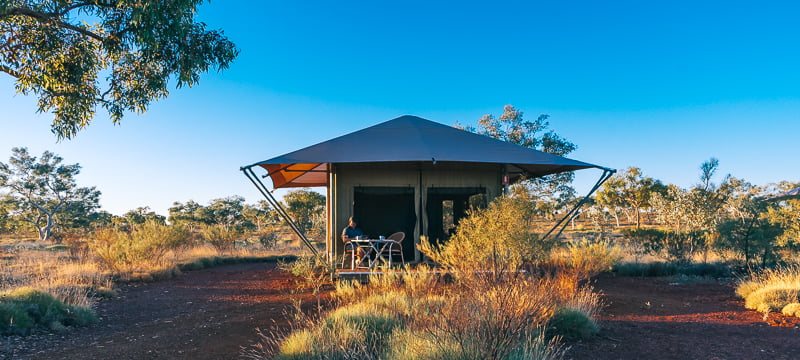
The best place to stay in Karijini National Park is within the park itself. This will give you the most time to enjoy the best parts of the park. There are two main options:
Karijini Eco Retreat is a comfortable option for staying in the National Park. An environmentally friendly retreat and campground nestled at Joffre Gorge, the award-winning Karijini Eco Retreat offers unpowered campsites and glamping accommodations. It also features an alfresco restaurant for dining. Here are the details:
- The entrance to the Eco Retreat is an unsealed 3-kilometre road
- Owned by a local Aboriginal corporation, all profits go towards supporting local Indigenous people of the Pilbara and park conservation.
- There is a small kiosk to purchase ice, ice creams, hot drinks, and essentials.
- An Outback Style Restaurant is open for breakfast, lunch, and dinner. You can book a table for a meal via email even if not staying at the Eco Retreat.
- Accommodation available at Unpowered campsites – pricing $20 per person per night; Standard Eco Tents – no power, shared ablutions; Deluxe Eco Tents – equipped with your own bathroom and Eco Cabins – the Retreat’s newest accommodation suited to couples, groups, and families.
- There are plenty of picnic tables and BBQs available.
Dales Campground is a great option for camping with its close proximity to some of the best swimming holes in the Park. Here are the details:
- The campground is within walking distance of Dales Gorge which includes Fortesque Falls, Fern Pool, and Circular Pool
- You’ll have access to well-maintained drop toilets
- Accommodation is on large, unpowered sites
- There are plenty of communal picnic tables and gas BBQs
- Bookings are highly recommended (book ahead for peak season or you’ll miss out)
- Showers are available at the visitor centre, 12km from the campground
- Camp fees (as at 05/2023) are $11 per adult pn, $7 concession pn, $3 child pn (5 to 16 years)
What to see at Karijini National Park?
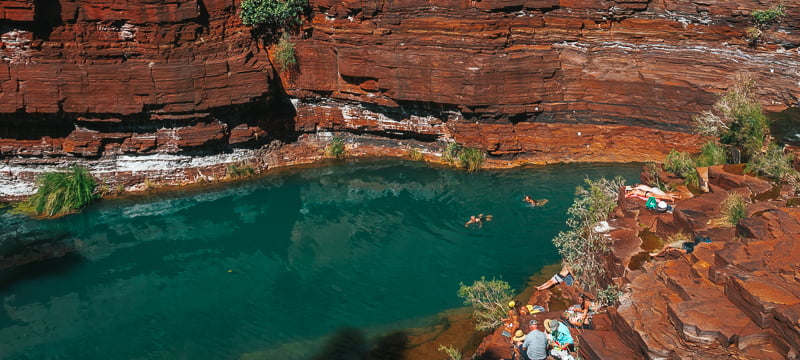
Dales Gorge – Fortescue Falls, Fern Pool, Circular Pool
Difficulty: Easy
Dales Gorge is one of the most accessible and easy to access right from the Dales Campground. It’s great for swimming and easy hiking. But that also means that during school holidays it’s busy with kids and families!
Metal stairs lead down from the campground to the beautiful, terraced spring-fed Fortescue Falls below. From here, turn right and it’s an easy walk to Fern Pool. This is always the warmest swimming area, as it gets the most sunlight throughout the day.
Walk the other way, and at the bottom of Fortescue Falls is a 2-kilometre (3 hour return) trail through the gorge and leading to Circular Pool a great place to swim and relax. At this end of the gorge, the hike to the top again is much steeper than at Fortescue. A short hike along the gorge edge will take you back to the day area, or you can follow the gorge in the other direction to reach the camping ground.
👉 Download Dales Gorge Trail Map
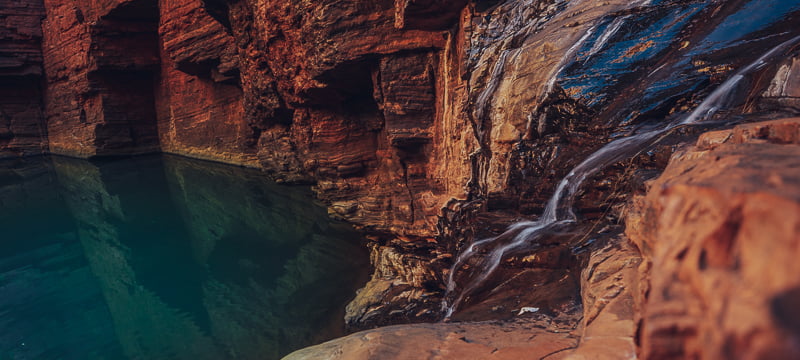
Weano Gorge – Handrail Pool
Difficulty: Medium – Hard
Weano Gorge is a 14-kilometre drive along an unsealed, gravel road from the Karijini Eco Retreat. This is one of the most popular gorges to hike. It starts off nice and easy with a gentle descent of Class 4, before turning into a more challenging Class 5 walk. Where the trail gets more difficult, there is the option to return to the gorge top or carry on. If you carry on, the only way forward is through waist-deep water. So be prepared to get wet.
At the end of Weano Gorge is Handrail Pool, a huge swimming area almost fully enclosed by the gorge walls high above. It’s spectacular and is named from the metal rail that was installed leading down to the water helping prevent accidents on the slippy rocks.
👉 Download Weano Gorge Trail Map
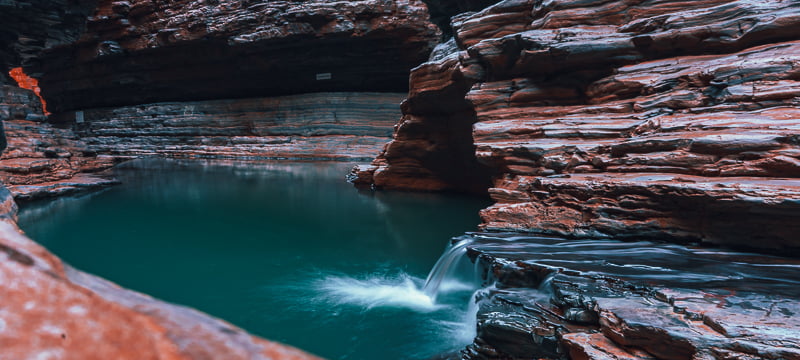
Hancock Gorge – Kermits Pool
Difficulty: Hard
Hancock Gorge is accessed from the same car park as Weano. The walk down into Hancock Gorge has been described as a ‘journey to the centre of the earth’ with walls twisting and turning, reaching vertical and closing in on both sides. One of the more adventurous gorges, this is the most challenging hike in the Karijini National Park that can be attempted without guides and prior permission from the Rangers.
It is steep, with an almost vertical metal ladder leading down to the gorge from the car park. Once at the bottom, it’s an easy walk along the creek bed until a narrow passageway between rocks where the only way forward is to either swim, wade or edge yourself along the solid rock that forms the gorge wall.
Make it over a small waterfall and you’ll reach the Spider Walk, a narrow confined gap that leads to Kermit’s Pool a beautifully deep green-coloured swimming area surrounded by high rocks. From here, there’s no way forward unless you have a guide and expertise. So it’s all the way back to the start again through the water and along the rock walls for most of us. Extreme caution should be taken when hiking through Hancock Gorge.
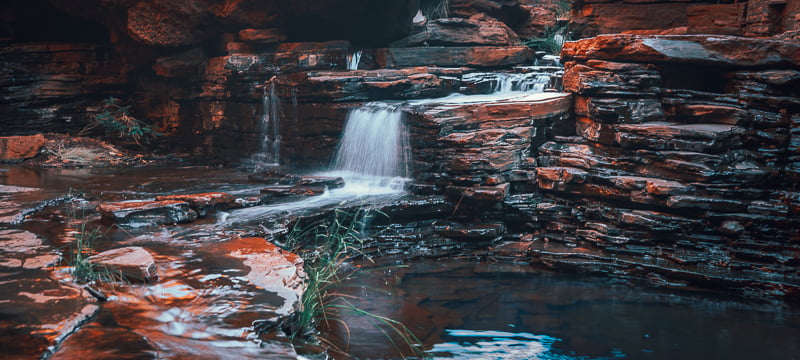
Joffre Gorge
Difficulty: Medium – Hard
Joffre Gorge is the site of a spectacular, cavernous waterfall that in the wet season erupts with flash floods under the weight of the Pilbara Summer storms and in the dry season is the perfect place to swim.
Right next to Karijini Eco Retreat, the walk from the restaurant to the gorge edge only takes 5 minutes through the red dust. From the lookout point, you can walk all the way around for awesome views above the waterfall itself and to a second viewing platform on the other side – a walk of about half an hour, or you can descend down into the waterfall itself.
The walk down isn’t very long but you have to be physically able to scramble and occasionally climb over rocks and boulders. This is why it is rated a Class 5 walk- or the most inaccessible walk on the rating scale. Turn right at the bottom of the gorge, and you reach the waterfall. In dry season, you can do this without getting wet if you want to.
Turn left at the bottom of Joffre Gorge, and that’s where the fun really begins. A short descent takes you into the deep ‘Olympic Swimming Pool’. This leads on for 300 metres to an island further down the gorge. Climb out here and you can walk to the edge of a massive drop. The view is awesome, but be careful as the water can be cold.
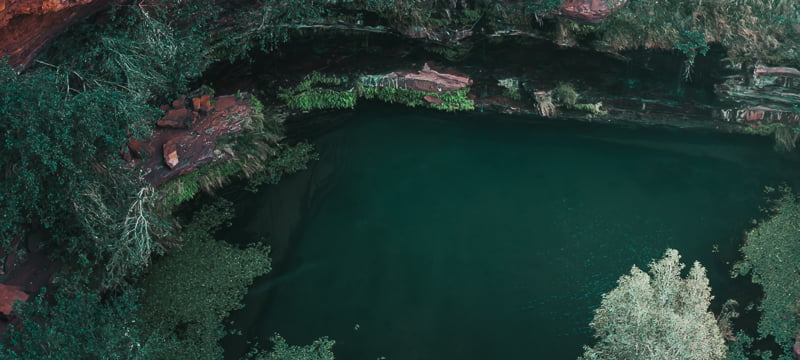
Hamersley Gorge
Difficulty: Medium
Hamersley Gorge is the most colourful gorge in Karijini. It’s also very different to the others. Most of Karijini’s gorges are narrow, confined and deep. Whilst Hamersley is open and wide, displaying exposed rock of layers of iron ore and minerals.
But, it’s a mission to get there! The gorge is at least 2 hours drive from the camping areas in the Park. And the only way in is along unsealed roads.
Much easier to access than others in the National Park, once there a trail leads you down into the gorge and to a small waterfall and a lovely swimming area. Swim along the river (or turn right at the bottom of the trail and follow the creek and clamber over the rocks) to reach the Spa Pool. This is possibly the most photographed location in the entire park. The rocks feature the most beautiful and intricate patterns caused by bending and buckling under pressure over millions of years.
Things to know before you go:
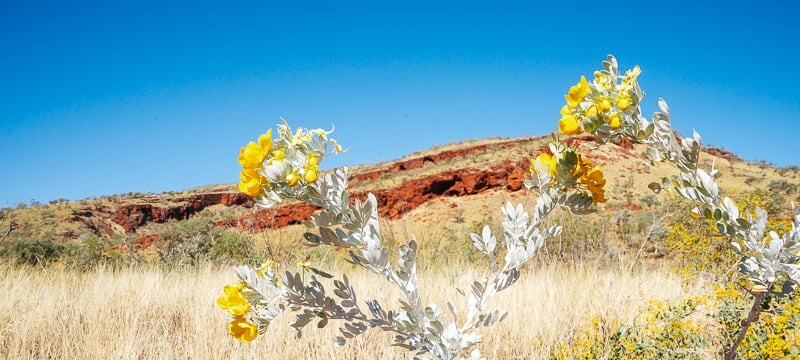
- There is an entry fee per vehicle to the National Park. The best option whether visiting or as a WA local is to purchase the Park Pass which covers park entry fees for private vehicles allowing unlimited entry to all parks in Western Australia for the duration of the pass. Holiday Passes are available for 4 weeks, or there is an Annual Pass which is much better value.
NOTE: RAC members get a discount on the Holiday Pass, Annual All Parks Pass, and the Concession Annual All Parks Pass when you purchase them through the RAC member benefits website - The only food option is at the Kiosk or restaurant at the Eco Retreat.
- Campers need to BYO water and no open wood fires are permitted within the National Park.
- There are no petrol stations within Karijini so it’s essential to bring ample fuel for travel within the park. The nearest fuel stop is at Tom Price, 80 kilometres west.
- Phone signal is minimal; Optus is the only provider that you may pick up signal around the Eco Retreat at Karijini, whereas Telstra is best elsewhere in the Pilbara.


